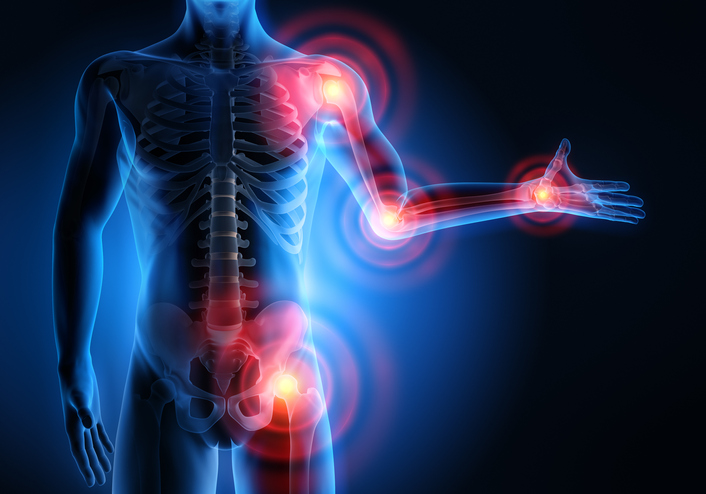Around the world, more than 400 million people suffer from joint pain. Joint pain can be caused by various conditions ranging from injury and arthritis to bursitis and gout. Knowing what is causing the pain can help you accurately diagnose the issue and determine the best treatment option. Here are 30 common causes of joint pain:
- Injuries, such as a fracture or sprain – Injury is an extremely common cause of joint pain, usually resulting from sports injuries, overuse falls, or other trauma to the body.
- Arthritis – Arthritis is a term for more than 100 diseases that cause inflammation in one or more joints and may lead to stiffness and pain. The most common types of arthritis are rheumatoid arthritis, osteoarthritis, and psoriatic arthritis.
- Bursitis is an inflammation of the bursa, a sac filled with fluid that cushions the bones and muscles around a joint. Repetitive motion or pressure can cause bursitis, resulting in pain and swelling.
- Gout occurs when uric acid builds up in the blood and forms crystals in the joints, causing sudden episodes of severe joint pain, tenderness, and redness.
- Osteoporosis is when bones become brittle due to decreased bone density over time. It can lead to weak bones and joint pain.
- Fibromyalgia – Fibromyalgia is a condition that causes widespread pain and tenderness throughout the body. It can cause joint stiffness and severe fatigue as well.
- Lupus is an autoimmune disease in which your body’s immune system mistakenly attacks healthy tissue, causing inflammation and joint pain.
- Tendinitis – Tendinitis is an inflammation caused by repetitive motion or overuse of a tendon, resulting in pain, swelling, and stiffness in the affected area.
Read Article: Tips On HealthCare: Planning A Vacation In The COVID Age
- Lyme Disease – Lyme disease is an infection caused by bacteria transmitted through a bite from an infected tick, resulting in joint pain, swelling, and other symptoms like fever and fatigue.
- Infectious Diseases – Various infectious diseases, such as measles and mumps, can cause joint pain due to inflammation of the joints.
- Carpal Tunnel Syndrome – Carpal tunnel syndrome is caused by pressure on the median nerve in the wrist, resulting in numbness, tingling, and pain in the hand, wrist, and arm.
- Scleroderma – Scleroderma is a chronic autoimmune disorder that causes hardening and tightening of the skin, often affecting the hands and feet with joint pain.
- Ankylosing Spondylitis – Ankylosing spondylitis is an inflammatory disorder that primarily affects the spine but can also affect other joints, causing pain and stiffness.
- Paget’s Disease – Paget’s disease is a disorder of the bone that causes an excessive breakdown and formation of bone tissue, leading to joint pain and deformity.
- Tennis Elbow – Tennis elbow is an injury caused by overuse of the tendons in the forearm that extend from the elbow to the wrist, resulting in pain in the elbow area.
- Rheumatic Fever – Rheumatic fever is an inflammatory disease caused by certain bacterial infections, such as strep throat, which can cause joint swelling and pain.
- Septic Arthritis – Septic arthritis is a bacterial infection that affects one or more joints and causes severe pain, swelling, and redness.
- Avascular Necrosis – Avascular necrosis is caused by the reduced blood supply to a bone, leading to joint pain, tenderness, swelling, and decreased range of motion.
- Stress Fractures – Stress fractures are tiny cracks or breaks in the bone due to overuse or repetitive activities like running or jumping. This can cause joint pain and swelling.
- Myofascial Pain Syndrome – Myofascial pain syndrome is a chronic musculoskeletal disorder caused by trigger points or tight bands of muscle fibers that press on nerves and cause localized pain around the affected area.
- Sjogren’s Syndrome – Sjogren’s syndrome is an autoimmune disorder that can cause joint pain and swelling due to dryness of the eyes and mouth.
- Reactive Arthritis – Reactive arthritis is an inflammatory type of arthritis caused by an infection in another part of the body, such as the urinary tract, which then spreads to the joints.
- Osteoarthritis – Osteoarthritis is a degenerative condition that causes cartilage damage, resulting in joint pain and stiffness.
- Hypermobility Syndrome – Hypermobility Syndrome is a condition where joints are unusually flexible, leading to instability and causing joint pain when overstretched or strained.
- Gout – A gout is a form of arthritis caused by an accumulation of uric acid crystals in the joints, leading to inflammation and pain.
- Fibromyalgia – Fibromyalgia is a chronic condition characterized by widespread musculoskeletal pain and fatigue, often resulting in joint stiffness and discomfort.
- Dupuytren’s Contracture – Dupuytren’s contracture is a progressive disorder resulting in the thickening of the connective tissue under the skin, causing the fingers to bend inward, leading to joint pain if left untreated.
- Charcot-Marie-Tooth Disease – Charcot-Marie-Tooth disease is a neurological disorder that affects the nerves in the feet and legs, often causing joint pain.
- Lyme Disease – Lyme disease is an infection caused by bacteria known as Borrelia burgdorferi, which can cause inflammation and pain in the joints if left untreated.
- Raynaud’s Syndrome – Raynaud’s syndrome is a condition that causes the decreased blood supply to certain areas due to spasms in the arteries, resulting in painful episodes of numbness or tingling sensations in the hands and feet.
Joint pain can be caused by various factors, from inflammatory disorders to chronic conditions and infections. Recognizing the signs and symptoms and seeking medical advice are essential for proper diagnosis and effective treatment.

